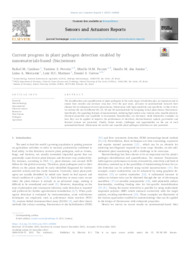Current progress in plant pathogen detection enabled by nanomaterials-based (bio)sensors.
Current progress in plant pathogen detection enabled by nanomaterials-based (bio)sensors.
Author(s): CARDOSO, R. M.; PEREIRA, T. S.; FACURE, M. H. M.; SANTOS, D. M.; MERCANTE, L. A.; MATTOSO, L. H. C.; CORREA, D. S.
Summary: The identification and quantification of plant pathogens in the early stages of infection play an important role to ensure food security and decrease crop loss. Over the past years, advances in nanomaterials research have allowed the development of novel plant disease (bio)sensors with high sensitivity and specificity. In this review, we address the use of different 0D, 1D, 2D and 3D nanomaterials for designing varied plant disease (bio)sensors. Specifically, the appealing features of nanomaterials, including high surface area/volume ratio, tunable physical-chemical properties and capability to incorporate biomolecules, are discussed, while illustrative examples on how they can be applied to improve the performance of electrical, electrochemical, optical, gravimetric and thermal sensors are presented. Finally, future trends, challenges and opportunities on the use of such nanomaterial-based (bio)sensors for on-site and expedite plant pathogen detection are also presented.
Publication year: 2022
Types of publication: Journal article
Unit: Embrapa Instrumentation
Keywords: Chemical sensors, Plant disease
Observation
Some of Embrapa's publications are published as ePub files. To read them, use or download one of the following free software options to your computer or mobile device. Android: Google Play Books; IOS: iBooks; Windows and Linux: Calibre.
Access other publications
Access the Agricultural Research Database (BDPA) to consult Embrapa's full library collection and records.
Visit Embrapa Bookstore to purchase books and other publications sold by Embrapa.

